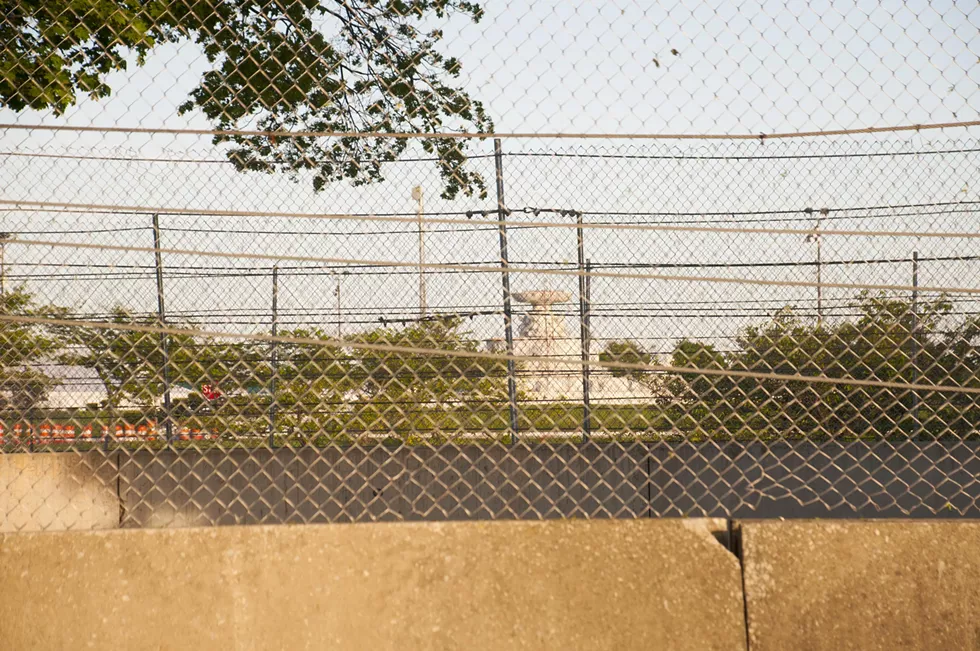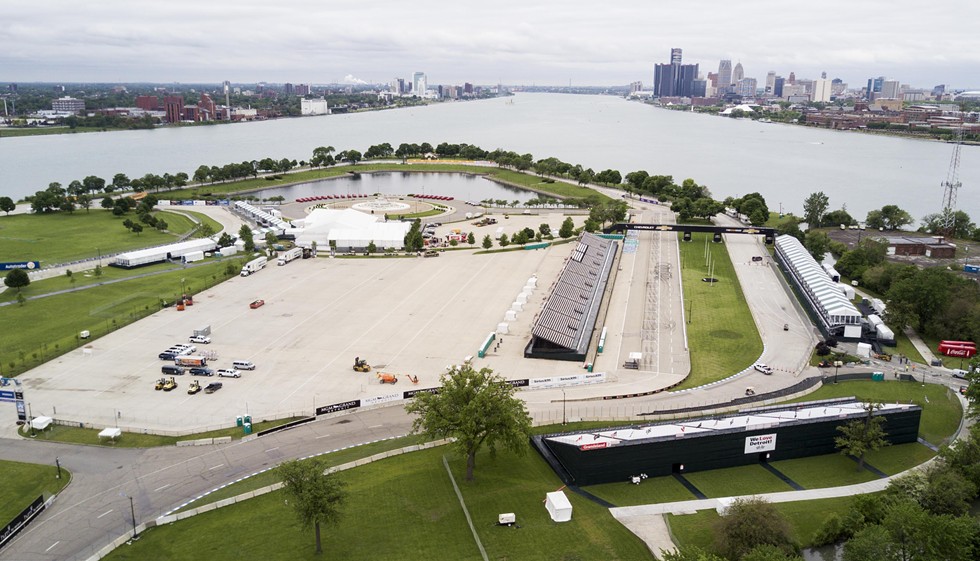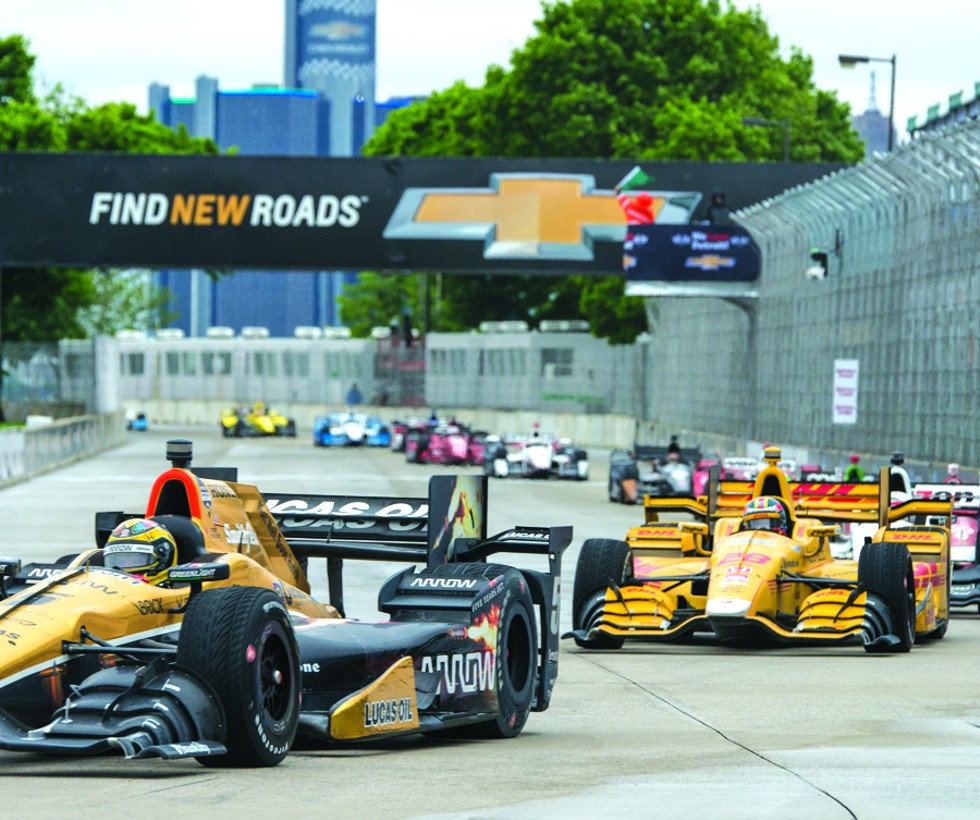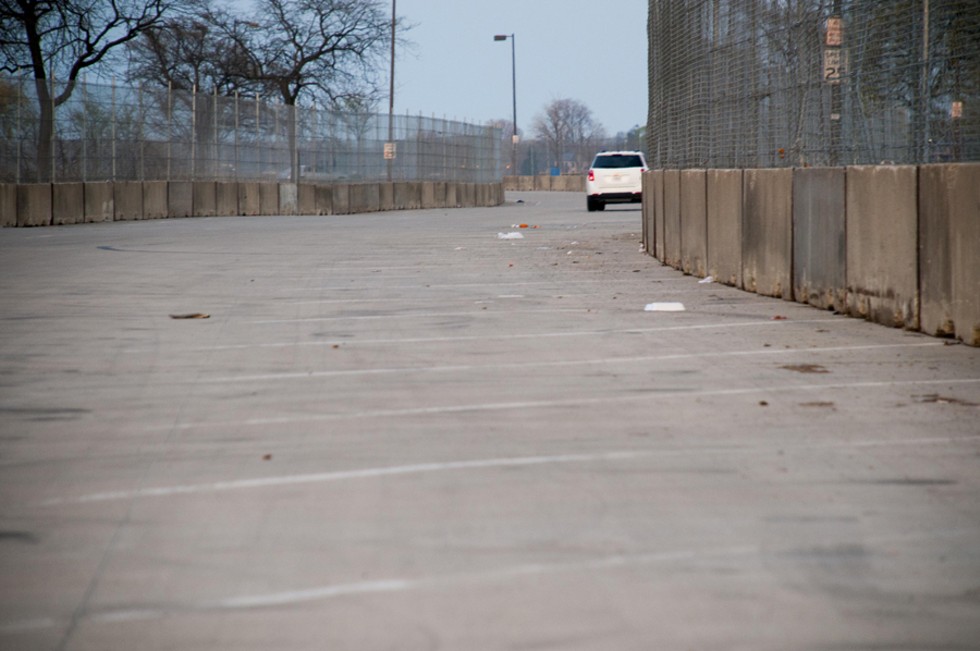Imagine opening up a newspaper and reading the following news article:
Brooklyn, MI — Gearheads are once again protesting outside the Michigan International Speedway as naturists begin setting up for the annual Michigan International Speedway Butterfly Show and Indigenous Bird Release.
The three-month preparation for the event begins April 8, when a group of hippies and bird watchers starts converting half of the raceway into a park. As part of the transformation, crews seedbomb the MIS's infield, lay sod over half of the concrete racetrack, and fill the pit area with native hornbeam and basswood trees.
In the middle of the racetrack's infield, naturists dug out a permanent 400,000-square-foot protected wetland. The late June show is marked by the release of a rainbow of butterfly species like the great spangled fritillary, tawny crescents, and gorgone checkerspot, which flutter above the raceway as a symphony of songs from piping plovers and sharp-tailed grouse fill the air. It's a joyous event filled with laughter and love, and is capped with a bonfire and moondance at the day's conclusion.
Yet gearheads and auto racing fans feel no joy. They view the annual event as disrespectful to car culture and a gross misuse of a facility that was clearly designed to be a racetrack, not a park and butterfly sanctuary.
Steve Catz, an activist who started a Facebook group called "Michigan International Speedway: Racetrack or Butterfly Sanctuary?", says its members will picket outside MLS today.
"I think it's quite clear that this facility was made for auto racing, not seedbombing," he argues.
However, naturists see it differently. They point out that they're only sodding over half of the race track, so drivers can use the other half. The racetrack is located amid the rolling slopes and kettle lakes of Irish Hills, so everything in the area should be used for nature, bird-watchers argue. They also highlight that the three-day show attracts 60,000 butterfly lovers and is a boon to local businesses.
Though there's increasing opposition to the event, its well-connected and wealthy organizer refuses to speak to anyone about the issues, except sympathetic alternative media outlets.
The idea that naturists would turn MIS into a park for a butterfly show is, of course, absurd. And yet that's arguably what happens each year — with the roles reversed — on Belle Isle, when the Detroit Grand Prix's organizers take over nearly half of the 982-acre island park for about three months each spring and summer, turning it into a heavy construction zone and, eventually, a 2.3-mile raceway. This year, construction for the June 2 through June 4 event started in early April, and breakdown will last several weeks beyond that.
While there's a lot of debate about the race's impact, a few things are objectively true. The construction project to set up and break down the Grand Prix stretches between 80 and 120 days — the longest of any race in the world, as we verified with other race organizers and media outlets.
Visit Belle Isle during the April, May, or June construction period, and you'll find the island's western half filled with concrete barriers, cables, portajohns, cell phone towers, trucks, forklifts, shipping containers, construction barrels, billboards, and miles of fencing. Next to the Scott Memorial Fountain, race organizer Roger Penske's team laid a permanent 400,000-square-foot concrete paddock, and Belle Isle's streets are left gridlocked with traffic jams when they start closing roads in the weeks around the race.
Understandably, the intrusion is dismaying and frustrating to many regular parkgoers who visit the island for its natural beauty.
Though most critics aren't calling for the race to be canceled altogether, many want the construction timeline to be shortened to several weeks, or the race moved to a different venue — downtown or City Airport are some suggested alternatives. That would leave southeast Michigan with both a world-class race and a park, as it can't have both in one venue, they argue.
But there are two sides to the debate. The gist of race organizers' and gearheads' case consists of a few points. Detroit is the Motor City, they say, and in the Motor City, even parks are race tracks. Penske spent a lot of money "fixing up" Belle Isle since 2012, so he should get carte blanche over it. The Grand Prix's charity event raises a lot of money for the park, and the event brings around 60,000 visitors to the island — therefore, it's worth the sacrifice. Also, there aren't any other venues that will work.
The debate over the competing philosophies reached a new pitch this year as the press coverage continued, the number of people and groups voicing frustration grew, and around 100 residents showed up to a planning session on March 29 on the island to ask for the race's removal. Then, in May, race fans allegedly began trying to intimidate freelance reporter Michael Betzold, who wrote critical stories about the race for Motor City Muckraker, calling him on his personal phone to harass him.
All this comes at an important moment for the Grand Prix's future. The Michigan Department of Natural Resources, which manages Belle Isle, is in the process of developing a long-term plan for its use. Separately, the contract with the city that allows Penske to convert the island into a racetrack for up to 11 weeks (though they've been allowed to go over that timeframe) is set to expire in 2018, but negotiations for a new contract are underway.
Over the next year, the DNR is going to decide what parkgoers' experience on Belle Isle will be like for many years to come. Is the island an events venue first, and a natural treasure second? Will it be filled with the roar of race cars and months of construction? Or will the island's management do something more in line with the Belle Isle Conservancy's mission, "to protect, preserve, restore, and enhance the natural environment, historic structures, and unique character of Belle Isle as a public park."
To get a handle on a complicated issue, we spoke with those on all sides — the DNR, the Belle Isle Conservancy, race fans, and a loosely organized group of park users who protest the race. Penske's team declined to comment for this story, but we previously spoke with them about many of the issues.
However, the deal could already be close to done. One island official told the Detroit City Council that the DNR will sign a new contract with Penske that only shortens the 11-week construction timeline by two weeks, though island officials later stressed that discussions are ongoing and nothing has been signed. Still, that news is troubling to Sandra Novacek, who has volunteered on Belle Isle for decades and helped organize the protests.
"It's not supposed to be for a private enterprise to monopolize it for 20 percent of the year. It's a public park and shouldn't be taken over in that way. It's really the only place of its kind in the city for people to go," she tells MT.
"I don't believe (Penske's team) is helping Detroit by destroying the natural landscape of what is a wonderful, premier park that's for its residents, but is taken over by a private enterprise."
Ron Olson, chief of the DNR's Parks and Recreation division, ultimately has the final say in what happens with regard to the race's future. In 2013, the then-going-bankrupt city of Detroit leased the island to the State of Michigan for 30 years, and it became our 102nd state park, putting it under Olson's purview. He previously said the city's contract tied the state's hands, and adds that he's for striking a balance.
"All big cities have these iconic events, and the race puts Detroit on the world stage," he says, stressing the benefit to the business community. "The economic impact is another impact that needs to be thought through."
The situation is exacerbated by Belle Isle's recent growing popularity. According to Olson, more than 4 million visited it last year, up by 600,000 from 2015. That comes as a result of both downtown's repopulation and the DNR's improvements to the island now bearing fruit. But that means more people live nearby and want to use the island for its intended purpose, and a coexistence with the race has grown more strained.
Of course, the Grand Prix's benefit to the business community comes at a cost. You'll need to visit Belle Isle to appreciate the scale of the construction project and its transformation from a park to a raceway. Like, for example, how those spectacular May and June sunsets in which the sun dips behind downtown's cityscape are marred by billboard-sized ads hanging from steel cables and fencing that — to someone who didn't know better — may seem in place to protect Belle Isle from a siege. Or how the four rows of fencing between the Scott Fountain and river aren't that dissimilar from what you might find on, say, Alcatraz.
But if you're going to experience all that, then you'll first have to get on the island, and that can prove difficult during the months of April, May, and June. That's when the Penske construction season is in full swing, and the MacArthur Bridge, Jefferson Avenue, and Sunset Drive are among Detroit's most congested roadways during many evenings as visitors sit in hour-long traffic jams to access the island. Then when the roads are clear, there are multiple State Troopers and DNR officers who set up speed traps (oh, the irony) to pull ticket revenue out of park visitors.
Even when there's less restriction in the construction's early and late stages, critics say the visual destruction of the island is one of the biggest issues: Five miles of cement barricades, protective fencing leave Sunset Drive looking more like the Lodge. Cell phone towers, and grandstands just don't fit in with the island's sassafras or river birch trees. Then there's the issue of noise pollution and the event's environmental impact, which critics have called on the DNR to study.
In past years, park users have returned to Belle Isle after the race to find that the vehicles jammed onto the island over race weekend turned acres of grass fields into acres of mud pit. Though the grass was quickly replaced, some of those areas were converted into permanent gravel pits or concrete lots.
Beyond that, it's also worth noting that no other state park in Michigan is subjected to this kind of event, and that leaves many frustrated — like Detroit resident Lizzy Emmons, who we talked with as she biked through the park.
"It looks bad. Mostly I just go somewhere else or to the other side (of the park). It's dangerous with concrete walls and everything else, so why bother?" she says.
Beyond anecdotal conversations with parkgoers, there's plenty more evidence of the increased frustration with the sustained headaches. Even the cheerleaders at The Free Press criticized the race over the traffic jams and have repeatedly reported on the annual issues. MLive questioned the construction timeline's length, covered the ongoing debate, and wrote about protests. Motor City Muckraker has kept watch on the planning process, while Metro Times documented Belle Isle "race fatigue and frustration."
Additionally, organizations like Detroit Audubon and the Detroit Greenways Coalition have made public statements about their concern.
"We do not support the programming of events like the Grand Prix or Red Bull car races," Detroit Audobon writes on its site. "These events and the infrastructure they require are in conflict with nature, are disruptive to birds, and they do not belong on Belle Isle."

Is there support?
Despite the opposition, the DNR says there's plenty of support for large scale events among the general population. Last year, it hired a marketing firm to gauge support for the race by calling random phone numbers in metro Detroit.
However, the survey's questions asked respondents — many of whom only visit the park once per year — if they supported the idea of holding the race on the island. Not surprisingly, 67 percent of residents agreed that Belle Isle was an appropriate location for large scale events, including the Grand Prix. Why not? On the face of it, the idea of holding the race here doesn't seem like a terrible idea.
However, actually doing so is much more complicated and controversial, and leads to a whole set of unforeseen issues that upset large numbers of park users.
The DNR's survey didn't ask about more specific problems, which include traffic jams, the three-month construction period, limited access, and so on. In fact, no one has polled regular park users to determine how they feel about the race and the aforementioned issues — until now.
Over the last year, we asked 50 parkgoers whether the Grand Prix should be moved off the island. Most of those who responded said they visit Belle Isle more than once per year, and 68 percent said the race should be held elsewhere.
A much larger number — 89 percent — said the construction should be shortened to four weeks or less, while 71 percent said it should be shortened to two weeks or less.
Of those we polled, 74 percent said they had been caught in a long traffic jam caused by Grand Prix construction, and 96 percent said traffic jams are a problem. Those we polled were most upset with the length of the construction timeline, the traffic jams, and the visual impact.
Other than our own informal survey, the DNR and Belle Isle Conservancy sought public input during a public input session for the DNR's planning. Reports from those who attended claim nearly all of the 100 people who showed up had one concern — the Grand Prix.
Protracted construction
At 11 weeks, the Detroit Grand Prix construction timeline is longer than any other IndyCar or Formula One street race in the world. While Penske's team has previously denied that their race is the longest, we verified this with other race organizers and media outlets.
In Toronto, for example, the Honda Indy assembled its 2014 race in the city's downtown in around three weeks. All work was done at night and required no full road closures except during race weekend, according to the Toronto Sun. That's despite the fact that crews were working within a much more complicated downtown setting. The setup and breakdown for the Grand Prix of St. Petersburg, Fla. was shortened from nine weeks to around three weeks following complaints from residents and the business community, according to the Tampa Tribune. And in Monaco, which hosts the largest street race in the world, construction and breakdown takes around seven weeks. Race organizers there contend with tight, winding streets, elevation shifts, and a track that runs through dense, urban areas that appear more challenging than Belle Isle.
A race with a construction and tear-down period of comparable length in Melbourne, Australia's Albert Park is highly divisive and subject to annual protests, which attracted as many as 20,000 residents one year. Parkgoers in Melbourne air grievances similar to those in Detroit, saying the construction schedule is too lengthy, and an urban, public park shouldn't be used for private auto racing three months each year.
If the Grand Prix's construction is shortened to nine weeks, then it will be in line with one other controversial race — the Long Beach Grand Prix.
Detroit Grand Prix chairman Bud Denker previously told MT construction here requires months because the track is the longest in the world. But a quick calculation shows that it takes Penske's crew 33.4 days to set up one mile of race track, while it takes Toronto's far more efficient crew approximately 11.8 days to set up one mile of track in a seemingly far more complicated environment.
Denker also previously claimed that the setup on Belle Isle takes more time because Penske's team takes extra precautions to make the race more safe. Despite this, a firefighter was injured during the 2015 Detroit Grand Prix, and the track deteriorated during the 2012 race, causing the race to be postponed.
In all likelihood, it's about the money: It costs less to slowly set up over months instead of days, and there's nothing in the contract stopping Penske from doing so.
Making the case for the race
It's true that Penske and his annual Grand Prixmiere charity raise a lot of money for the island. In 2015, it pulled in $1.1 million for the Belle Isle Conservancy, and just under $500,000 in 2016. On top of that, Penske pays $200,000 annually to use the park.
The charity funds are a giant boost for the Conservancy, which previously had a budget of $500,000. Conservancy president Michele Hodges notes that the haul pays to run the aquarium and makes other programming possible.
"Public-partner partnerships are important to the advancement of the Conservancy's mission," she says, adding that the relationship is no different from when other nonprofits partner with different enterprises.
She adds, "Going forward, we will need to move into a capital campaign mode as we require a significant number of corporate and individual partnerships."
But is it possible to partner with organizations that won't demand use of the island for three months in return for money? Novacek, who volunteers with organizations that seek donations from philanthropists and foundations, thinks so.
She says it's likely that foundations were less interested in Belle Isle 10 years ago because the then-corrupt city government mismanaged the island, and there was no guarantee that philanthropists' support would go to improving and sustaining it. With the DNR in control and running the island properly, she says, philanthropists are much more likely to support the cause.
Moreover, Novacek says the money that the Grand Prixmiere raises and Penske pays is small potatoes compared to what's out there via foundations that won't require converting the island into a racetrack.
"If you need the money, at least get it from someone who will follow the mission of the Conservancy," she adds. "Find other donors that share this mission to preserve, promote, and protect the natural landscape of Belle Isle, instead of using the money from an organization that doesn't have that mission."
However, many race fans argue that since Penske paid for so many improvements to the island, he deserves control. They use colorful descriptions like "shithole" to describe the island before Penske's team arrived, and credit him with singlehandedly cleaning it up.
It should be noted that the DNR and Conservancy made some wonderful improvements in recent years. But there's no evidence to support claims, for example, that crime on the island is down. A Detroit Police official previously told MT that there are no numbers to support that because there was so little crime to begin with.
It's also worth taking a closer look at Penske's investment. He says he spent $4.5 million laying a racetrack and $250,000 installing a drainage system around the raceway's footprint. He has also helped fund or paid for new LED lighting on the MacArthur Bridge, the cement paddock for the race crews, improvements to the Casino where media and race personnel operate, improvements to the Scott Memorial Fountain, new sidewalks around the racetrack, new benches around the race, improvements to picnic shelters around his track, and so on.
But regular park users say Penske building a raceway on Belle Isle for his own purposes shouldn't be misrepresented as an act of generosity to improve a public park. There's also a debate over what qualifies as an improvement. Is a permanent 10-acre cement paddock and widened roads an improvement? Critics say, "no."
Beyond that, officials argue that attendance hit 65,000 in 2015, and organizers claimed in 2014 there was a $47 million economic benefit for the city. Opponents argue that the race could be moved elsewhere and have the benefit of maintaining both attractions. Also, sporting event's economic impacts are often greatly exaggerated, and the island's isolation leaves many especially skeptical of that economic impact.
However, the isolation could be the key to the island's appeal for the Grand Prix, says Eliot Erlandson, a 23-year-old automotive designer who races in his spare time, started a now-international car club in high school, and teaches an auto design course at the College for Creative Studies. He notes that race tracks around the nation are closing due to noise complaints. In Michigan, there used to be 192 tracks. Now, less than 40 remain.
"Predominantly, the reason it wouldn't work somewhere else in the city is because ... of noise. Try putting a track in the middle of the city — it'll get closed down as fast as it opens," he tells MT. "Part of it is that the noise is further away from people out on the island."
What's next?
Like Erlandson, Olson says he doesn't know where the Grand Prix would go if the state doesn't sign another contract with Penske. Of course, that shouldn't be his problem. His concern is the park's well being, and his fear over what would happen should the state not re-up with Penske reveals a lot about where Olson's mind is at on the issue.
Otherwise, it's a joy to listen to Olson talk about all of his other plans for Belle Isle, and, with the DNR here, there's now the kind of leadership and competence that was missing from one of Detroit's treasures for so long.
The DNR's planning process, Olson tells MT, includes considering how to redevelop the island's defunct zoo, redevelop the vacant boathouse, deal with aging infrastructure like sewer and water lines, improve services like pavilion rentals, and generate more revenue so that the park is in a much more sustainable position. He mentions taking landscape architect Frederick Law Olmsted's original vision into consideration, and nurturing and sustaining Belle Isle while improving its assets.
"The big, main goal is to get the island restored, but to be careful about new ideas," Olson says. "We have to have a very thoughtful process and make sure we don't make enthusiastic short-term decisions without thinking about longer-term impact."
On those issues, the DNR and race critics seem to agree on what's best for the island and the park, and it will seek more public input in June or July, Olson says. But where the DNR and regular park users' visions diverge is when the Grand Prix is brought up.
There's also a little bit of concern that a new Penske deal is already done, and the Grand Prix will still have nine weeks of construction to set up — not much of a change. However, Olson says "nothing is set in stone."
While the DNR is in charge, a lot of the frustration over the race has been directed toward Hodges' Conservancy, though she stresses that while the Conservancy has a voice in the process, it doesn't make decisions. She notes that the city signed the contract with Penske and her nonprofit is working with it. The Conservancy, she adds, has "never made a value judgment" about the situation. In other words, it's neutral, which, in such an emotional debate, is a difficult position to be in.
Still, in response to questions about her support for the race, she clarifies, "There are some things that need to be addressed, and this will be the first opportunity for the DNR to do that in earnest. The DNR will have to look hard at what is acceptable and what's not."
Another option for those who want a future free of Belle Isle auto racing is to work with state representatives, but the district in which Belle Isle is situated was represented by Brian Banks. He was forced to resign as part of a plea deal in a February assault case, and his seat has yet to be filled. In the Senate, Belle Isle's district is represented by Sen. Coleman Young II, who is in the midst of a mayoral run and didn't return the MT's requests for comment. And it's hard to imagine a scenario in which the Republican-run state government stands up to a billionaire on behalf of park users.
Thus the most encouraging sign is that the Conservancy is embarking on a new capital funding campaign. Perhaps once it's demonstrated that the island can stand on its own without sacrificing its assets, then the state might be more inclined to run the island sans an auto race.










